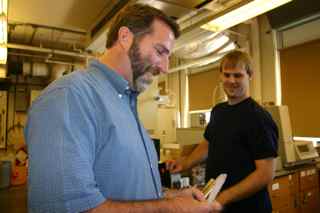Alternative Method for Processing Leather

Inventor: Douglas Raynie
Article and Photo by Lance Nixon
South Dakota State University research funded in part by the Environmental Protection Agency could lead to a cleaner, greener leather tanning industry.
SDSU research associate professor Douglas Raynie has a grant of $350,000 from the EPA to study an alternative method for processing leather. The project uses liquid carbon dioxide instead of water as a carrier for the chemicals used in different stages of tanning leather.
The EPA is interested because conventional leather processing generates a lot of pollutants. The SDSU project is funded under a program to develop green manufacturing processes.
Raynie, in SDSU’s Department of Chemistry and Biochemistry, said there hasn’t been a great deal of change through history in the steps involved in leather tanning.
“Processors take the animal hide and put it in a solution that will remove the hair and the grease from the hides. Then they salt the hides and add, in olden days, vegetable tanning — that is, the tannins from tree bark and other plant material. In more recent times, they use chromium salts, and chromium is a heavy metal that is considered a toxic waste. This process is very lengthy, it can take anywhere from several days to a month or more, and it generates a lot of wastewater and associated wastes.”
The SDSU research uses liquid carbon dioxide — that is, carbon dioxide under a high pressure. At room temperature, as much as 800 pounds per square inch of pressure is needed. Under such conditions carbon dioxide shows some properties of a gas and some properties of a liquid. It would permeate more like a gas, and could be used as a carrier like water, for example.
Raynie said. “One of the properties of liquid carbon dioxide that is attractive for this process is that it will permeate into the leather much faster than water, so we replaced the water and use the carbon dioxide as the carrier. Now, it will allow for a much faster process and hopefully a more continuous process.”
Additionally, the carbon dioxide can be vented away as a gas once the process is complete, which means the pollutants will fall out of solution so that they can be recovered and treated appropriately. Or alternately, if the carbon dioxide is to be reused, it can be strained through a membrane to remove pollutants.
“It’s much easier to remove the waste such as chromium with the CO2 process,” Raynie said. In a water solution, by contrast, removing chromium and other wastes is more difficult.
Raynie said regulatory concerns have been so great in the U.S. that most of the leather-tanning industry is now based in other countries. Raynie said a new method for tanning leather could bring some of those jobs back.
“There is still a lot of infrastructure in the U.S., as well as the growing trend for more of the cottage industries or local industries. So I could see industries on a small scale, a regional leather tanner providing material for a regional shoe company or interactions of that nature.”
One of the advantages of carbon dioxide, Raynie noted, is that subtle variations of temperature and pressure change its solubility properties.
“We can work under certain conditions when we want to favor solubility, and then adjust the temperature and pressure under conditions where we want to minimize the solubility to recover material,” he said.
The project — in which Raynie is directing research by Ph.D. student Jeremy Kroon — is focusing on the last stages of the leather tanning process first: waterproofing, dyeing, degreasing, regreasing.
Those are steps where the materials have a high degree of solubility in carbon dioxide, meaning there’s a high probability of success. In fact, Raynie notes, dyeing is already done using carbon dioxide in the textile industry.
One of the SDSU project’s first efforts will look at waterproofing agents. The gas-like diffusion properties of liquid carbon dioxide may make for greater penetration.
“Our thought is if we can impregnate the leather with the waterproofing agent rather than just perform a surface coating, that the waterproofing agent will last a lot longer, so it will be a much more durable finished product,” Raynie said. “Carbon dioxide would act as the carrier to bring in the waterproofing agent.”
SDSU will eventually evaluate carbon dioxide in other stages of the tanning process as well.